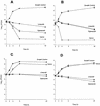Comparative in vitro activities and postantibiotic effects of the oxazolidinone compounds eperezolid (PNU-100592) and linezolid (PNU-100766) versus vancomycin against Staphylococcus aureus, coagulase-negative staphylococci, Enterococcus faecalis, and Enterococcus faecium
- PMID: 9517963
- PMCID: PMC105529
- DOI: 10.1128/AAC.42.3.721
Comparative in vitro activities and postantibiotic effects of the oxazolidinone compounds eperezolid (PNU-100592) and linezolid (PNU-100766) versus vancomycin against Staphylococcus aureus, coagulase-negative staphylococci, Enterococcus faecalis, and Enterococcus faecium
Abstract
The activities of the oxazolidinone antibacterial agents eperezolid (PNU-100592) and linezolid (PNU-100766) were compared with that of vancomycin against clinical isolates of methicillin-susceptible and -resistant Staphylococcus aureus (n = 200), coagulase-negative staphylococci (n = 100), and vancomycin-susceptible and -resistant Enterococcus faecalis and Enterococcus faecium (n = 50). Eperezolid and linezolid demonstrated good in vitro inhibitory activity, regardless of methicillin susceptibility for staphylococci (MIC at which 90% of the isolates are inhibited [MIC90] range, 1 to 4 microg/ml) or vancomycin susceptibility for enterococci (MIC90 range, 1 to 4 microg/ml). In time-kill studies, eperezolid and linezolid were bacteriostatic in action. A postantibiotic effect of 0.8+/-0.5 h was demonstrated for both eperezolid and linezolid against S. aureus, S. epidermidis, E. faecalis, and E. faecium.
Figures

Similar articles
-
Comparative activity of linezolid against staphylococci and enterococci isolated in Italy.Clin Microbiol Infect. 2002 Jun;8(6):368-72. doi: 10.1046/j.1469-0691.2002.00429.x. Clin Microbiol Infect. 2002. PMID: 12084106
-
Activities of the oxazolidinones linezolid and eperezolid in experimental intra-abdominal abscess due to Enterococcus faecalis or vancomycin-resistant Enterococcus faecium.Antimicrob Agents Chemother. 1999 Dec;43(12):2873-6. doi: 10.1128/AAC.43.12.2873. Antimicrob Agents Chemother. 1999. PMID: 10582874 Free PMC article.
-
In vitro activities of Daptomycin, Linezolid, and Quinupristin-Dalfopristin against a challenge panel of Staphylococci and Enterococci, including vancomycin-intermediate staphylococcus aureus and vancomycin-resistant Enterococcus faecium.Microb Drug Resist. 2003 Winter;9(4):389-93. doi: 10.1089/107662903322762833. Microb Drug Resist. 2003. PMID: 15000746
-
Treatment options for vancomycin-resistant enterococcal infections.Drugs. 2002;62(3):425-41. doi: 10.2165/00003495-200262030-00002. Drugs. 2002. PMID: 11827558 Review.
-
In vitro activity of daptomycin against clinical isolates with reduced susceptibilities to linezolid and quinupristin/dalfopristin.Int J Antimicrob Agents. 2006 Nov;28(5):385-8. doi: 10.1016/j.ijantimicag.2006.07.017. Int J Antimicrob Agents. 2006. PMID: 17046205 Review.
Cited by
-
Effect of linezolid in comparison with that of vancomycin on glycocalix production: in vitro study.Antimicrob Agents Chemother. 2002 Feb;46(2):598-9. doi: 10.1128/AAC.46.2.598-599.2002. Antimicrob Agents Chemother. 2002. PMID: 11796388 Free PMC article. No abstract available.
-
Linezolid compared with vancomycin for the prevention of methicillin-resistant Staphylococcus aureus or Staphylococcus epidermidis vascular graft infection in rats: A randomized, controlled, experimental study.Curr Ther Res Clin Exp. 2007 Jan;68(1):23-31. doi: 10.1016/j.curtheres.2007.02.001. Curr Ther Res Clin Exp. 2007. PMID: 24678116 Free PMC article.
-
Coagulase-negative staphylococci.Clin Microbiol Rev. 2014 Oct;27(4):870-926. doi: 10.1128/CMR.00109-13. Clin Microbiol Rev. 2014. PMID: 25278577 Free PMC article. Review.
-
In vitro activities of quinupristin-dalfopristin and cefepime, alone and in combination with various antimicrobials, against multidrug-resistant staphylococci and enterococci in an in vitro pharmacodynamic model.Antimicrob Agents Chemother. 2002 Aug;46(8):2606-12. doi: 10.1128/AAC.46.8.2606-2612.2002. Antimicrob Agents Chemother. 2002. PMID: 12121940 Free PMC article.
-
Impaired target site penetration of vancomycin in diabetic patients following cardiac surgery.Antimicrob Agents Chemother. 2006 Apr;50(4):1372-5. doi: 10.1128/AAC.50.4.1372-1375.2006. Antimicrob Agents Chemother. 2006. PMID: 16569854 Free PMC article.
References
-
- Brumfitt W, Hamilton-Miller J M T. Antibacterial oxazolidinones. In vitro activity of a new analogue, E3709. Diagn Microbiol Infect Dis. 1992;15:621–624. - PubMed
-
- Craig W A, Gudmundsson S. Postantibiotic effect. In: Lorian V, editor. Antibiotics in laboratory medicine. 3rd ed. Baltimore, Md: The Williams & Wilkins Co.; 1991. pp. 403–431.
-
- Daly J S, Eliopolous G M, Reiszner E, Moellering R C., Jr Mechanism of action and activity of DuP 105 and DuP 721, new oxazolidinone compounds. J Antimicrob Chemother. 1988;21:721–730. - PubMed
Publication types
MeSH terms
Substances
LinkOut - more resources
Full Text Sources
Medical

